American Sabbatical 022: 9/27/96
Cody
9/27... And then it goes UP.
After a good night’s sleep the world looked less tilted. We did housekeeping on Festiva. Jiffy lube and vac. Top the
liquids, check the rubber. Did a laundry with coffee, tea, and
muffins. Shipped excess baggage home (all those puter manuals
I haven’t needed.. yet). Repacked and headed uphill. The bright
sunny morning had grayed over by the time we left Sheridan, and
the Big Horn Mountains that stand like a gigantic stage set behind
the town had disappeared into storm clouds.
| We drove out of September into January as we rose into the clouds.
At 7000 feet Festiva began to lose her head and suffer from oxygen
deprivation, but we were in no hurry anyhow. Lucky thing. Coming
round a bend at about 8000 feet there was a Bronco in the other
lane with his hazards flashing, and the driver was waving a red
flag out the window. Wide load, I figured. Then around the next
bend came a herd of cattle filling the narrow road from cliff
wall to drop-off. Three cowboys on horseback and one in a stock
truck herded the doggies past, into blowing sleet, as we zigged
and zagged through the livestock. |
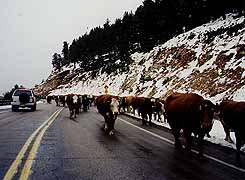
Loose Stock
|
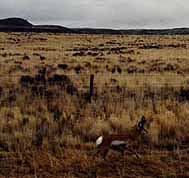
Antelope
|
A great country, where the national parklands have “Loose Stock”
signs, and the deer and the antelope play. We saw a lot of them,
too. Pronghorns grazing by the highway. The early travelers reported
them too easily spooked to stalk, but they could be tricked into
range by lying on the ground and kicking your legs in the air.
Their curiosity was just too much for their better sense. They
must think Detroit’s best are the strangest thing yet, and don’t
spook until you slow to point a camera at them. |
| We didn’t point the camera too much today. Not that the vertiginous
switchback weren’t spectacular, but the view off the edge into
empty clouds only made us hang on tight, not grab for the Olympus.
At 9000 feet we chatted up a flag woman in her 50’s who held us
at one end of a construction zone. She said the last snow had
been in June, so they’d had an average roadwork season, two months
of summer. |
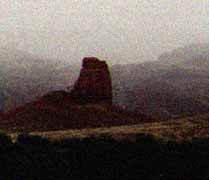
Spire in snow
|
After two hours on the Big Horns we descended into plunging valleys
on the western slope. Throughout the mountains there were roadside
information signs identifying the rock formations alongside, Cretaceous,
Jurassic, Precambrian. Go looking for history and you get 450
million years worth. At Shell Creek Falls the feds have provided
a paved overlook and walk, so we stretched our legs in the chill
wet air. The signs talked about the big horn sheep that have been
“reintroduced”, and there was a telescope to watch them. They
were busy watching tourists elsewhere. All we saw was a soggy
baby rabbit hiding under a mountain mahogany bush
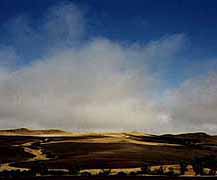
Blowing off
|
.The west slope of the Big Horns spits you out through a dramatic
cleft in the eons into an even drier landscape, approaching high
desert after this year’s drought: the Big Horn Basin. As we moved
out onto it, all we saw was a vast flat expanse of sagebrush and
sparse grasses without horizon. But then the clouds began to lift
like a curtain, to the west and southwest, and the shining mountains
rose up to enclose our vision. The Absarokas, black and white
with snow, and glistening under the silver skirts of the stormclouds.
The contrast between the sear brown hills in the foreground and
the leaping black and whites beyond had us weaving all over the
road as we rolled down into Cody. |
| We’d been told that there was a superb museum at Cody, but no
one had warned us about the western art collection. Breath-taking.
Catlin, Bodmer, Miller, Remington, NC Wyeth, Bierstadt, Moran,
Henry Jackson, and on and on. I take it back. You can paint the
West. Granted, most of the artists chose big canvases to tell
a big story, but some of them caught the light and the sweep without
raising their voices. We could only take an hour’s worth of eyefill
before we had to go out and try our hands at the sunset. And what
a setting. Mountains jumping out of the plain all around. |
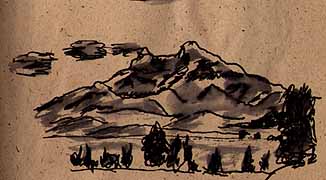
Absarokas (Bryce)
|
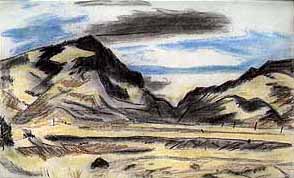
Peggy's Cody
|
We goggled into a motel and asked for a room with a view. “We’re
sorry, none of our rooms have views.” Hah. You could sell the
picture out this window to hang on the walls of motels all over
America.. in fact, I think they do. And it kept changing, as the
bad weather moved out and the westering light painted the remains
gold and salmon. Now a full moon is riding the sky fields. Last
night we watched the lunar eclipse over the Wal*Mart in Sheridan.
Tonight she’ll set behind the Absarokas. |
(Memo #22)
|
Sept. 27. - Western Art, Buffalo Bill Center, Cody, Wyo.
Who? Buffalo Bill Cody, Western artists
What? Buffalo Bill Historical Center 4 museums (western art, Plains
Indian, Buffalo Bill, firearms)
Where? Cody, Wyoming (NW section of state), eastern gateway to
Yellowstone
When? 1900s to the present
How? by museum collectors
Topics: Western art, museums.
Questions: What makes a great museum? What is Western art? Is
Western art taken seriously in the art world? |
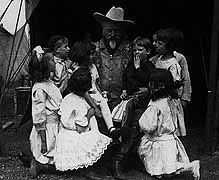
Ol Bill
|
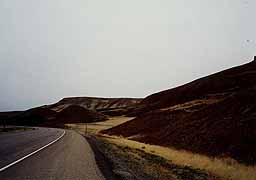
Debouching onto naked plains
|
We drove into Cody, Wyoming, after a first foray into the Rocky
Mountains. There was snow flying up there and hairpin turns and
beautiful views. A road crew was getting a last stretch paved
before winter closed in (!). One worker said they’d had snow once
on the 4th of July. We crossed the Bighorn Range into the high
dry basin in central northern Wyoming, endless sage-dotted flats
with pronghorn antelopes. Cody sits at the eastern edge of the
next Rocky chains, a lovely small city in the foothills with spectacular
mountains views in three directions. Several e-mail friends, and
a trucker, had said we MUST get to the museum in Cody.
|
| The Buffalo Bill Historical Center sits on the western edge of
town and is four museums in one - a Western art museum, a Plains
Indian museum, a Buffalo Bill museum, a firearms museum. There
is also a contemporary art gallery. The building itself is beautiful
- gray stone with occasional sets of huge windows looking to the
mountains and two green sculpture courtyards with mountains, plants
and trees. The four museums have individual spaces. It was obvious
that the buildings were made for the collection not vice versa.
Some museums give you the impressions of artifacts crammed into
awkward preexisting rooms, this was spacious and comfortable and
appropriate to the specific collection. |
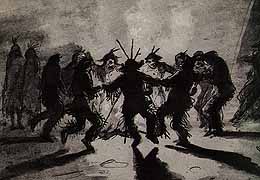
Trappers Dancing
(Alfred Jacob Miller)
|
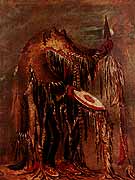
Blackfoot
Medicine Man
(Catlin)
|
The Western art gallery has a large collection of the artists
identified with the West: Frederick Remington, Henry Jackson,
George Catlin, Thomas Moran, Alfred Bierstadt. Each has a distinctive
style and role. George Catlin was one of the earliest explorer-artists
recording the vanishing cultures - his paintings of Mandan villages
especially are in most American History books. He was the first
white to see the quarry where the Plains tribes got the stone
for their pipes.The museum shows posters and books from the European
exhibition tour of Catlin’s paintings. Thomas Moran was in the
first official expedition to Yellowstone and his paintings helped
convince Congress to create the park. His paintings are vast mountain
landscapes in great detail and color, a Hudson school approach
to the west (although the canvases are not huge - as some Hudson
school works are). “The Golden Gate” is his best known picture
of Yellowstone. Bierstadt also did grand views in realistic detail
in oil. The collection is big enough to have variety of subject
and media. In preparation for the oil paintings Moran made watercolor
sketches that are really lovely.
|
| Remington and Jackson are both artists who are labeled “illustrators”.
Both did, in fact, produce works of art for magazines and books.
Remington illustrated two of Theodore Roosevelt’s books on the
West. The pictures tell a story in vivid detail: breaking a horse,
eating by a campfire, standing nightwatch on a cattle drive. |
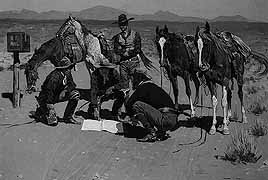
Cowboy Mail
(Remington)
|
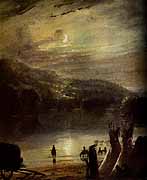
Night Crossing
(Miller)
|
The gallery tackles the controversial roles of illustrator and
artist this way: “This type of art has sometimes been criticized
as ‘merely’ illustration, implying a lack of creativity on the
part of the artist because he did not necessarily originate the
subject matter. Yet the best illustrators can stand on their own
as works of art. These artists use the elements of art to make
strong visual statements while following a long tradition of storytelling
through painting” |
There were Western paintings by several other famous illustrator-artists:
N.C. Wyeth and W.H.D. Koerner. Many of these artists had trained
with Howard Pyle (best known for his Robin Hood illustrations).
There were a number of sculptures, mainly in bronze. One Henry
Jackson sculpture shows a berserk bronco with rider. The contorted
figures “stand” on one of the horse’s legs. President Ford apparently
gave a copy of this to Queen Elizabeth to celebrate the American
bicentennial!! Did she take offense at the implication? |
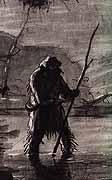
Setting Traps
(Miller)
|
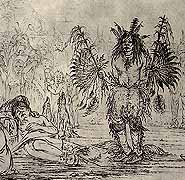
Mandan Medicine
(Catllin)
|
There was a whole section of animal paintings. The New York Zoological
Society funded work to preserve animals in nature and art, much
as ethnological societies were funding artists to preserve vanishing
cultures. The museum also has two full artists’ studios - Remington’s
had many western artifacts on the walls and floors - cowboy hats
and pottery and bows and skulls and blankets. |
| In the Western art gallery and contemporary gallery, the people
and landforms of the West are presented in every conceivable medium
and technique - there are impressionist views of Indian villages
in lovely pastels, mixed media collages, formal portraits of Indians
in traditional dress and modern attire. I think you can apply
any standard of great art to the works we saw and they would stand
the test. |
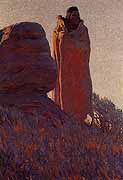
The Medicine Robe
(Maynard Dixon)
|
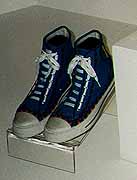
Beaded Hightops
|
The Plains Indian museum is wonderfully built. You walk up a long
solarium toward a real tipi which fills the entrance space. There
are fullscale figures of Indians and horses with traditional adornment
throughout. Galleries are devoted to individual subjects like
“personal adornment” and “religion”. The display cases do not
seem crowded. Each object has its space and importance. One had
a display of Plains Indian toys, another of cradle boards and
other child gear. Even a ceiling high case with over forty pairs
of beaded moccasins did not seem cluttered. The emphasis is on
the craftsmanship as well as the cultural details. A huge space
at the back of the museum with three “balconies” overlooking has
a fullscale settlement with three fully stocked tepees, staked
hides and outside structures. It is terrific!
|
The gun museum and Buffalo Bill Museums have impressive collections
that are well displayed. Buffalo Bill was a showman who took his
Wild West Show with a number of Plains Indians to Europe many
times. He merchandised the west in ways that are still being done
- for example, we met a man who leads week long wagon train trips
for tourists.
We loved the Cody Center and kept revisiting specific paintings
or objects on our two visits. I wonder if I would have liked the
museum as a child. Or would I have wanted to join a museum activity,
trying to embroider with porcupine quills or eat pemmican? Do
we appreciate museums differently at specific ages? Could we design
a Freeport retail museum? What makes a great museum? We’ve seen
a variety: indoor, outdoor, diorama, display cases, recreated
dwellings, digs. Some are great, some aren’t. I’m still trying
to figure out what makes the difference. |
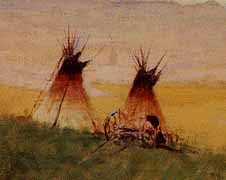
Impressionistic Remington
|
9/28.. Cody.
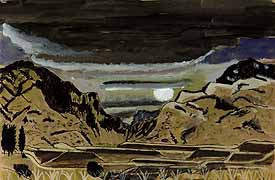
Bryce's Cody
|
A full moon peeked in the motel window in Cody this morning, and by the time dawn turned the thin clouds
salmon we were munching on cereal and plotting another assault
on the Buffalo Bill Cody Museum . A stiff breeze was snapping
the flags, but, for a change, it was a mild westerly, and the
big red bluff west of town glowed in the morning sun. Damn, but
Wyoming can seduce you. |
Now, you might expect a Buffalo Bill museum to be a lot of glitz
and gewgaws. After all, Cody was the greatest self-promoter since
P.T.himself. The consummate showman. Which makes the superb quality
of this museum, out here under the stage-set mountains, even more
stunning.
| There are few public spaces that are truly welcoming, and the
air of importance in most of them spoils the greeting. Not so
this time. The open airiness inside matches the vistas outside,
and the inner courtyards and the huge glass wall looking out at
the mountains keep you in the landscape. The presentation is uncluttered
and without pretension. That may be because ‘Western” art is the
idiot stepchild of American ART. Which patronizing is absurd,
of course. Here again is a regional art that mirrors a place,
and needn’t apologize to anyone about its mastery. |
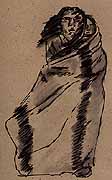
Sacagawea
(Statue by Henry Jackson)
|
Yesterday we soaked up to our necks in the Morans and Remingtons,
the Catlins and Millers, and a lot of unfamiliar painters (to
us) who managed to grab something of the critter. Now don’t get
me wrong. There’s lots of bronc-busting, sixgun toting, peacepipe
passing, ten-gallon hatting in this stuff. We are talking about
Cowboy Country, pardner. And the tall tale, all that schmaltz
about man and horse, and the edgy mix of frontier bravado and
vanishing native culture.. that’s part of the landscape, too.
Where else would a painted bronze statue of John Wayne as The
Marshal galloping into the sunset grace the lobby? But the mix
in this collection walks that affective tightrope between iconography
and insight. Story and study. All the expected symbols are in
evidence, but they don’t overwhelm the graceful watercolor that
tells of the high plains with a few strokes, or the impressionist
Indian who stands before that glowing western sky. And the charge
coming off the earliest records of discovery is telekinetic. Particularly
the group scenes by Catlin in the Mandan villages. They have an
almost pictographic style (unlike his familiar portraits), which
almost approaches the traditional native pictography. As though
Catlin was touched by the culture he was recording, and we are
gripped in turn.
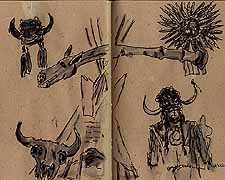
Artifacts (Bryce)
|
But we’d immersed ourselves in those waters yesterday, so we indulged
in the Plains Indian Collection for starters, today. I’ll let
Peggy describe the effectiveness of it as a cultural exposition,
but from an esthetic angle it’s a knockout. For me, the hair-raiser
was the display of ritual objects. While I was alone in that space,
it was full of corner-of-the-eye creatures. Figures lurking just
out of sight. The investment of spirit energy in objects, in the
making, and in the using, leaves a charge that is palpable to
a sympathetic imagination. But it wasn’t a heavy charge, there’s
a lot of sacred laughter in Native American spirituality, and
there were echoes of laughter in the collection as well as chanting
voices, and ghost dancers. |
It was encouraging that the collection included contemporary Native
images and objects, like school mascots and beaded sneakers. And
the contemporary Western art exhibition had some wicked goodies..
often by women taking a poke at the cowboy macho.
Then we went back into the art collection to revisit the masters.
After trying our hands, unsatisfactorily, at this landscape, it
is very discouraging to see it done with such apparent ease, but
we had to taste the chocolates one more time.



















